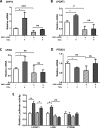Profiling of promoter occupancy by the SND1 transcriptional coactivator identifies downstream glycerolipid metabolic genes involved in TNFα response in human hepatoma cells
- PMID: 26323317
- PMCID: PMC4678849
- DOI: 10.1093/nar/gkv858
Profiling of promoter occupancy by the SND1 transcriptional coactivator identifies downstream glycerolipid metabolic genes involved in TNFα response in human hepatoma cells
Abstract
The NF-κB-inducible Staphylococcal nuclease and tudor domain-containing 1 gene (SND1) encodes a coactivator involved in inflammatory responses and tumorigenesis. While SND1 is known to interact with certain transcription factors and activate client gene expression, no comprehensive mapping of SND1 target genes has been reported. Here, we have approached this question by performing ChIP-chip assays on human hepatoma HepG2 cells and analyzing SND1 binding modulation by proinflammatory TNFα. We show that SND1 binds 645 gene promoters in control cells and 281 additional genes in TNFα-treated cells. Transcription factor binding site analysis of bound probes identified motifs for established partners and for novel transcription factors including HSF, ATF, STAT3, MEIS1/AHOXA9, E2F and p300/CREB. Major target genes were involved in gene expression and RNA metabolism regulation, as well as development and cellular metabolism. We confirmed SND1 binding to 21 previously unrecognized genes, including a set of glycerolipid genes. Knocking-down experiments revealed that SND1 deficiency compromises the glycerolipid gene reprogramming and lipid phenotypic responses to TNFα. Overall, our findings uncover an unexpected large set of potential SND1 target genes and partners and reveal SND1 to be a determinant downstream effector of TNFα that contributes to support glycerophospholipid homeostasis in human hepatocellular carcinoma during inflammation.
© The Author(s) 2015. Published by Oxford University Press on behalf of Nucleic Acids Research.
Figures






Similar articles
-
Insights Into SND1 Oncogene Promoter Regulation.Front Oncol. 2018 Dec 11;8:606. doi: 10.3389/fonc.2018.00606. eCollection 2018. Front Oncol. 2018. PMID: 30619748 Free PMC article. Review.
-
NF-κB, Sp1 and NF-Y as transcriptional regulators of human SND1 gene.Biochimie. 2013 Apr;95(4):735-42. doi: 10.1016/j.biochi.2012.10.029. Epub 2012 Nov 15. Biochimie. 2013. PMID: 23160072
-
SND1 overexpression deregulates cholesterol homeostasis in hepatocellular carcinoma.Biochim Biophys Acta. 2016 Sep;1861(9 Pt A):988-996. doi: 10.1016/j.bbalip.2016.05.011. Epub 2016 May 26. Biochim Biophys Acta. 2016. PMID: 27238764
-
SND1 affects proliferation of hepatocellular carcinoma cell line SMMC-7721 by regulating IGFBP3 expression.Anat Rec (Hoboken). 2013 Oct;296(10):1568-75. doi: 10.1002/ar.22737. Epub 2013 Jul 22. Anat Rec (Hoboken). 2013. PMID: 23878061
-
Role of the staphylococcal nuclease and tudor domain containing 1 in oncogenesis (review).Int J Oncol. 2015 Feb;46(2):465-73. doi: 10.3892/ijo.2014.2766. Epub 2014 Nov 18. Int J Oncol. 2015. PMID: 25405367 Free PMC article. Review.
Cited by
-
Mitochondrion-Localized SND1 Promotes Mitophagy and Liver Cancer Progression Through PGAM5.Front Oncol. 2022 Mar 31;12:857968. doi: 10.3389/fonc.2022.857968. eCollection 2022. Front Oncol. 2022. PMID: 35433434 Free PMC article.
-
Insights Into SND1 Oncogene Promoter Regulation.Front Oncol. 2018 Dec 11;8:606. doi: 10.3389/fonc.2018.00606. eCollection 2018. Front Oncol. 2018. PMID: 30619748 Free PMC article. Review.
-
Lipidomic data uncover extensive heterogeneity in phosphatidylcholine structural variants in HepG2 cells.Data Brief. 2019 Oct 4;27:104608. doi: 10.1016/j.dib.2019.104608. eCollection 2019 Dec. Data Brief. 2019. PMID: 31667320 Free PMC article.
-
Linc00668 Promotes Invasion and Stem Cell-Like Properties of Breast Cancer Cells by Interaction With SND1.Front Oncol. 2020 Feb 14;10:88. doi: 10.3389/fonc.2020.00088. eCollection 2020. Front Oncol. 2020. PMID: 32117742 Free PMC article.
-
Tudor-SN Regulates Milk Synthesis and Proliferation of Bovine Mammary Epithelial Cells.Int J Mol Sci. 2015 Dec 16;16(12):29936-47. doi: 10.3390/ijms161226212. Int J Mol Sci. 2015. PMID: 26694361 Free PMC article.
References
-
- Broadhurst M.K., Wheeler T.T. The p100 coactivator is present in the nuclei of mammary epithelial cells and its abundance is increased in response to prolactin in culture and in mammary tissue during lactation. J. Endocrinol. 2001;171:329–337. - PubMed
-
- Zhao C.T., Shi K.H., Su Y., Liang L.Y., Yan Y., Postlethwait J., Meng A.M. Two variants of zebrafish p100 are expressed during embryogenesis and regulated by nodal signaling. FEBS Lett. 2003;543:190–195. - PubMed
-
- Hossain M.J., Korde R., Singh P.K., Kanodia S., Ranjan R., Ram G., Kalsey G.S., Singh R., Malhotra P. Plasmodium falciparum tudor staphylococcal nuclease interacting proteins suggest its role in nuclear as well as splicing processes. Gene. 2010;468:48–57. - PubMed
-
- Rodriguez L., Ochoa B., Martinez M.J. NF-Y and Sp1 are involved in transcriptional regulation of rat SND p102 gene. Biochem. Biophys. Res. Commun. 2007;356:226–232. - PubMed
Publication types
MeSH terms
Substances
LinkOut - more resources
Full Text Sources
Other Literature Sources
Medical
Molecular Biology Databases
Miscellaneous

